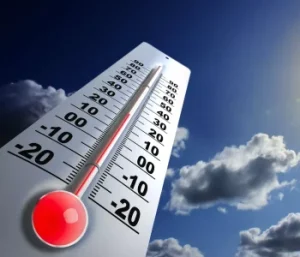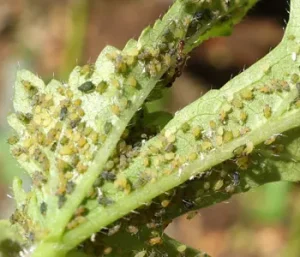According to a study published in Nature, some of our staple crops could face “substantial” production losses due to climate disruption, even if farmers adapt to worsening weather conditions. The yields of corn, soybeans, rice, wheat, cassava, and sorghum are projected to decline by 120 calories per person per day for each degree of global warming, with average daily losses equivalent to skipping breakfast. The study suggests that rising incomes and changes in farming practices could mitigate these losses by about a quarter by 2050 and a third by 2100, but not eliminate them entirely. “In a high-warming future, we still see global calorie productivity losses of around 25%,” said Andrew Hultgren, an environmental economist at the University of Illinois Urbana-Champaign and lead author of the study.
Farmers are among the hardest hit by extreme weather events, but scientists have struggled to quantify the effects of climate change on food production. One major source of uncertainty is the extent to which farmers will adapt to higher temperatures by changing crops, adjusting planting and harvesting times, and modifying cultivation methods.
The scale and nature of climate disruption effects vary by region and crop. The main challenges stem from rising temperatures, water stress, extreme weather events, diseases and pests, and the double-edged fertilizing effect of CO₂.
Climate disruption leads to a widespread decline in agricultural yields for most crops in the long term due to a combination of factors such as higher temperatures, water stress, and increased frequency of extreme weather events. While some regions may experience temporary benefits, global projections indicate growing vulnerability and major challenges for food security. Recent studies suggest that rice may be the least affected crop in terms of yield decline by 2100, thanks to its high adaptability. Below is a review of the negative effects of climate disruption on major food crops.
1. The Facets of Climate Disruption



Rising Temperatures
Corn and wheat: High temperatures can shorten crop cycles, reducing biomass accumulation and yields. Heatwaves during grain filling are particularly damaging. However, in colder regions, moderate temperature increases may initially be beneficial, allowing earlier planting and longer photosynthesis periods. In the long term, rising temperatures exceed optimal tolerance thresholds in many regions.
Rice: High temperatures can induce heat stress, affecting growth and development. Warmer conditions shorten the growth cycle, potentially reducing yields.
Sorghum: Extreme heat can damage plant cells and increase sterility rates during flowering, lowering yields. However, some studies suggest sorghum may be resilient to temperature increases in certain areas, with potential benefits in some scenarios.
Soybeans: Higher temperatures can promote the spread of diseases like target spot, though the overall impact on productivity depends on CO₂ levels and other factors.
Cassava: While relatively drought-resistant, cassava is sensitive to temperature fluctuations that affect its growth cycle and tuber development.
Water Stress
- All these crops are vulnerable to droughts, which reduce water availability essential for growth and productivity. Erratic rainfall, with intense downpours followed by dry spells, can cause flooding (leading to crop losses) or water deficits.
- Corn, wheat, and sorghum are particularly affected by rainfall variability and droughts.
- Cassava, though drought-tolerant (surviving 4-6 months of drought thanks to its tuberous roots), is still impacted by prolonged droughts or waterlogging.
- Rice, a water-dependent crop, is directly affected by changes in rainfall patterns, whether through water scarcity or flooding.
Extreme Weather Events
- The increasing frequency and intensity of heatwaves, floods, storms, and cold spells can destroy crops, reduce yields, and damage agricultural infrastructure.
- These events can devastate corn, wheat, rice, soybean, and sorghum harvests, leading to significant losses for farmers. For example, soft wheat has seen poor harvests due to climate disruption.
Disease and Pest Impacts
Climate change can alter the geographic distribution and intensity of diseases and pests, creating favorable conditions for their spread or pushing them into new areas. For example, soybean target spot is one such disease.
The Double-Edged Fertilizing Effect of CO₂
Increased atmospheric carbon dioxide (CO₂) can stimulate photosynthesis and potentially boost productivity and dry matter yields in some crops. However, this benefit is often offset by other negative climate factors, such as extreme temperatures and water stress.
Several agricultural practices have emerged that can, to some extent, mitigate the negative effects of climate disruption, slowing—though not reversing—the downward trend in yields.
2. Practices to Combat Climate Disruption

The current agricultural practices of cultivating plants essential to adapt to climate change involve a combination of genetic (adapted varieties) and agronomic (water, soil, crop management) strategies to build more resilient and sustainable agricultural systems. There are universal practices and practices specific to each culture.
General practices for adapting to climate change are as follows:
- Varietal breeding: developing and using crop varieties that are more resistant to drought, heat, disease and pests (which can proliferate with climate change) or varieties with shorter growth cycles to escape periods of water stress or intense heat.
- Crop diversification and rotations: introduce a greater variety of crops into the crop rotation, including legumes, to improve soil health, reduce risks from specific diseases and pests, and increase the overall resilience of the system to climate hazards.
- Conservation agriculture:
- Reduced tillage: Reducing tillage helps preserve soil structure, increase organic matter content and improve water-retaining capacity.
- Permanent soil cover: Maintaining vegetation cover (cover crops, crop residues) helps protect the soil from erosion, limit water evaporation, and enrich organic matter.
- Water management:
-
- Controlled, precision irrigation: use efficient irrigation techniques (drip, micro-irrigation) and sensors to optimize water supply and reduce waste.
- Water collection and storage: Setting up systems to collect and store rainwater.
- Soil moisture conservation practices: tied dikes, planting pits, or contour crops to retain water.
- Agroecology and agroforestry: integrating trees into agricultural systems (agroforestry) to provide shade, reduce evaporation, improve biodiversity and stabilize soils. Agroecological practices aim to strengthen the natural processes of ecosystems.
- Rational fertilisation: optimise the supply of fertilisers, particularly nitrogen, to limit greenhouse gas emissions and promote better absorption by plants. Use analysis tools (satellites, drones) for precision fertilization.
- Staggered sowing/planting dates: adjust sowing and harvesting schedules so that the most sensitive phases of the crops (flowering, grain filling) avoid periods of climatic stress (drought, high temperatures)
Specific practices per crop include:
- Maize:
- Adaptation of sowing dates and choice of variety: farmers often bring forward sowing dates and use later varieties when rainfall and temperatures allow it or earlier periods to avoid water stress at the end of the cycle. The exploitation of the genetic diversity of maize flowering is also studied.
- Increased fertilizer input (in some contexts): Higher fertilizer levels can reduce yield declines in future climates, but this varies by cultivar.
- Agricultural diversification and agroforestry
- Wheat:
- Varietal selection: developing varieties resistant to water and heat stress
- Staggered crop cycles: earlier sowing or earlier varieties to avoid water stress.
- Diversification of crop rotation: introduce legumes and more complex rotations.
- Agroforestry and hedgerows: providing shade and preserving soil moisture.
- Wheat mixtures: use mixtures of varieties with complementary resistances
- Rice:
- Intensive Rice Cultivation System (SRI): this approach increases yields while reducing water consumption (up to 50%) and greenhouse gas emissions (methane, up to 70%). It is based on:
- Planting healthy seedlings
- Optimizing plant spacing
- Building a fertile (organic matter) and healthy soil
- The application of a minimum amount of water necessary.
- Development of resilient varieties: resistance to pests, diseases, extreme temperatures, droughts and storms.
- Intensive Rice Cultivation System (SRI): this approach increases yields while reducing water consumption (up to 50%) and greenhouse gas emissions (methane, up to 70%). It is based on:
- Sorghum:
- Climate-smart strain breeding: cultivars that lengthen the growing and reproductive cycles, improve grain filling, and optimize resource allocation.
- Drip irrigation and humidity sensors for efficient water use.
- Facilities for moisture conservation: linked dikes, pits and contour crops.
- Flood recession sorghum: In Chad, this variety is grown after the receding waters, allowing two harvests per year and offering an innovative solution to climate challenges in flood-prone areas.
- Soybean:
- Intercropping (polyculture): Pairing soybeans with corn can improve yields and reduce losses.
- Selection of adapted varieties resistant to irregular climatic conditions (rainfall)
- Disease management: Selecting varieties with longer cycles, adjusting the planting schedule, and applying fungicides early are strategies to mitigate the risks of fungal diseases.
- Cassava:
- Climate-smart agriculture: adoption of nutrient, water and soil management practices.
- Application of organic fertilizers: this is a commonly adopted practice
- Diversification of crops and multiple varieties to increase resilience
- Change in planting techniques: change in the orientation of cassava stalks
- Intercropping: Cassava is often combined with maize.
- Development of varieties tolerant to extreme conditions (excessive rainfall, heat, flooding) and resistance to pests and diseases.
3. Nuances
A team of US and Chinese researchers used data from 12,658 regions in 54 countries to determine the extent to which food producers have adapted to different climate changes. They applied these historical relationships to models simulating future agricultural production as temperatures rise and economies expand, and compared the losses with a hypothetical world in which global warming would have stopped in the early 2000s.
According to the study, in an extreme warming scenario, the relative yield of a crop such as soybeans would fall by 26% by 2100, even taking into account adaptation, increased incomes, and the effect of faster plant growth due to increased carbon dioxide in the atmosphere.
A more realistic warming scenario — closer to the level that current policies will cause — would result in yield losses of 16 percent for soybeans, 7.7 percent for wheat and 8.3 percent for corn, according to the study. Rice is the only one of the six crops studied whose yields are expected to increase due to climate change, with an expected gain of 4.9%.
The world’s population is expected to grow from about 8 billion today to 10 billion by the end of the century, increasing demand for food as carbon pollution changes weather patterns. The researchers found that the greatest losses would be in modern “breadbasket” regions with highly productive land, but added that people in the poorest countries would be among those who could least afford food.
The research, which uses econometric methods to assess the total effect of adaptation, contrasts with previous studies that explicitly model biophysical interactions. A study published in Nature Communications in 2022 and using the latter approach showed that timely adaptation of growing periods would increase actual crop yields by 12%.
Jonas Jägermeyr, a researcher at the Columbia Climate School and a co-author of the study, said the new research did not cover adaptation options that are not being implemented today and that its results were likely to be too pessimistic.
” Empirical impact studies are notorious for being too pessimistic when it comes to distant scenarios ,” he said. “Process-based models show the importance of plant growth interactions that cannot be trained empirically based on historical data”.
But these models have also been criticized because they explore what is theoretically possible without considering real-world constraints, such as market failures, human error, and the availability of funds.
“The conclusions [of the new study] are reasonable, but they represent one of the extremes of a legitimate scientific debate,” said Ehsan Eyshi Rezaei, a crop scientist at the Leibniz Centre for Agricultural Landscape Research.
He added, ” I see these results as a valuable confrontation with empirical reality showing that we cannot assume that a perfect fit will save us – even if the truth probably lies between their pessimistic projections and the optimistic projections of [other researchers] .”
Despite uncertainties, some reasons for cautious optimism remain:
- Differences between crops: While the general trend is towards lower yields, the impact varies between crops. Some recent studies suggest that rice, for example, could experience a smaller decline in yields than other cereals (4.9% increase by 2100 in a moderate emissions scenario) thanks to its greater adaptability and the ability of farmers to adjust their practices. On the other hand, sorghum, wheat and soybeans could see their yields fall more significantly.
- CO2 effect: The increased concentration of CO2 in the atmosphere can, in some cases, have a fertilizing effect on certain plants (the “carbon fertilization” effect), potentially partially offsetting the negative effects of temperature. However, this effect is often limited by other factors (water, nutrients) and is usually not sufficient to reverse the overall trend of declining yields.
- Adaptation strategies: Good practices can, as discussed above, mitigate yield declines, but cannot completely cancel them out.
Ultimately, despite adaptation efforts, science indicates that major food crops—corn, wheat, rice, sorghum, soybeans, and cassava—face a future of declining yields due to unavoidable climate impacts. While adaptation is crucial for food security, it cannot fully counteract the underlying trend.
Sources: The Guardian, Nature.




